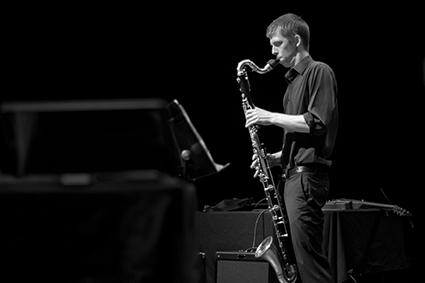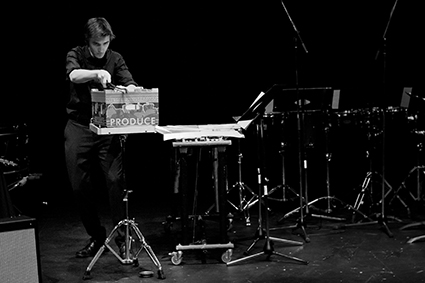 |
Breaking Out Young Composers’ Night photo Holly Jade |
In Out Into Stillness, Sally Banyard sets Western Australian poet Kevin Gillam’s “Flotsam and Crows” for alto, piano and saxophone ensemble. The sprung rhythm of Gillam’s poem is half sung and half spoken by Lila Raubenheimer against saxophone chords of gorgeous plenitude. Banyard bases the harmony of Out Into Stillness on Gillam’s line “minor ninth—unresolved.” As the poem moves from the poet’s interior reflections to the ward in which he walks bathed in fluorescent light, the piano strikes up a lively tango exploring chains of sumptuous dissonances.
For his saxophone orchestra composition Octagonal Raven, Sean Bernard promised “a fun and energetic piece” making use of the complex and changing time signatures of progressive rock. He certainly delivered. The Basement Saxx were expertly navigated through Bernard’s tightly packed metric modulations by conductor Matt Styles. The orchestra exhibited tight ensemble dynamics, bringing out the piece’s call and response sections and building tension through vamping episodes before exploding into full-bodied chordal textures.
From the rhythmic excesses of progressive rock to focussed gestural experimentation, Josiah Padmanabham wove three modes of playing across a string trio in Simulacra? The piece included well-crafted solos for each instrument, including a darting violin solo with rapid string crossings and glissandi, a meandering viola solo with left-hand strumming and a wild cello solo with harmonics and tremolos.
John Pax presented the only solo piece of the night, Foreshortening for solo bass clarinet. The piece is an extended exploration of a trilling, key-clacking motif which is transposed and articulated across the instrument. Clarinettist Gareth Hearne sustained an intense sense of focus as he voyaged across the whispering score.
Laura Halligan’s Desperada superimposes minimalist electronics and gritty violin amplified through a piezo transducer. Operating the electronic part, Halligan develops a sense of urgency through loud and unrelenting rhythms. Violinist Pippa Lester plays a series of escalating motifs, from single pizzicato notes to raw scrubbing.
Traced Over for guitar and electronics is an exploration of the spectral profile of a bowed acoustic guitar. The guitarist’s gestures (played by Jameson Feakes) are electronically echoed and amplified by the composer James Bradbury. As the piece progresses, these echoes become more heavily modified. As Feakes bows the guitar more roughly, the sounds become harder for the electronics to identify and modify. By contrast, the piece ends with some of the purest tones possible on the guitar: an EBow resonating a string with some wonderful punctuations of plucked strings above the nut.
 |
Breaking Out Young Composers’ Night photo Holly Jade |
Josten Myburgh—who deserves an extra vote of thanks for organising the concert—presented his New-Complexity-inflected piece Doctor for soprano, two percussionists and electronics. Myburgh sets up the expectation of a large-scale dynamic gradient such as “soft to loud” in his program note, only to humorously subvert it by playing a minute of ear-splitting noise and dropping right down to silence. As soprano Sarah Cranfield, dressed all in black with thick-rimmed glasses, repeats a staccato “chi-chi-chi-chi,” the theatrical piece begins to resemble Ligeti’s Le grand macabre, with Cranfield as Barbara Hannigan. Myburgh makes good use of the two vibraphones, with beguiling bell-tones forming a shifting bed under Cranfield’s vocalisations. Percussionist Thomas Robertson turns away from the vibraphone to occupy himself with two recent staples of new music percussion: cardboard box and Styrofoam, both played with a bow. These effects should be employed sparingly to avoid redundancy, but when used, it should be vigorously. I was sad to see the styrofoam completely intact and the edges of the box barely dented at the end of the performance. The percussionists then began a section with brushes playing staggered rhythms on toms, an excellent effect susurrating underneath Cranfield’s vocals.
Elise Reitze’s Tom Bomb should win an award for best program note, which consisted of a single bomb emoji. The piece was a choreographic riot worthy of Taikoz. Three percussionists are spaced around a bass drum, playing with the backs of drumsticks. Together they make complex rhythms, occasionally playing ‘Mexican waves’ and breaking the air with cracking rim shots. One player has a weight on the drum near him, adding light and shade to the drum’s tone. The performers move onto smaller toms, playing with their hands. The piece builds to a climax, the performers raising their sticks high above their heads.
Ben Christiansen takes Albert Camus’ novel The Plague as a point of inspiration for Carousel for two saxophones, two percussionists and piano. Or at least, he takes as inspiration the character Joseph Grand, who wants to write a novel but is such a perfectionist that he cannot get past the first sentence. Christiansen’s stuttering piece similarly struggles to get going. An opening attack is restated over and over again in different ways, with trills, tremolos, different dynamics and meters. And yet, unlike Grand’s novel, somehow a work is made. A very satisfying and enjoyable work, even. Just as the piece never really begins, the ending is also ambiguous thanks to an excellent performative gesture by Christiansen, who also conducted the piece. He suddenly drops his arms and turns for a bow as though he had just decided that enough is enough.
The final work of the evening raised the performative stakes with a homage to the Perth-based performance artist and lo-fi folk-pop singer Agamous Betty. Betty was kind enough to participate in this homage, performing Maddington Laundry in a delightful range of orange-red pastels and crooning out the indecipherable lyrics of the mournful song. Meanwhile, Woolley prepared a table-mounted guitar and played recordings through a hand-held tape player as Betty mimed along. Woolley also produced crunchy poppings by rubbing a metal ruler over the pickups (turn down your amp first if you want to try that one at home).
It was encouraging to see the level of mutual support between the young performers and composers in the Breaking Out program, as well as hearing the command with which the composers wielded their diverse musical styles.
PICA and Totally Huge New Music Festival, Breaking Out Young Composers’ Night, PICA, Perth, 20 May
© Matthew Lorenzon; for permission to reproduce apply to [email protected]








 back
back